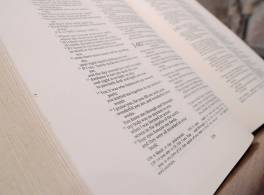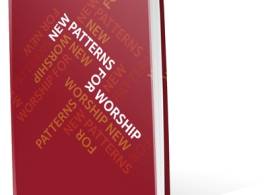Stories from the four churches
♥
St Ann’s PCC has recently had to discuss ‘Who has the authority to change the worship in our parish church?’ This is because a number of people in the church would like to see a return to the Prayer Book for some services. At the beginning of Common Worship, on the authorization page (page vii), is a summary of Canon B 3:
Canon B 3 provides that decisions as to which of the authorized services are to be used (other than occasional offices) shall be taken jointly by the incumbent and the parochial church council. In the case of occasional offices (other than Confirmation and Ordination), the decision is to be made by the minister conducting the service, subject to the right of any of the persons concerned to object beforehand to the form of service proposed.
The spirit of this Canon, and of the Worship and Doctrine Measure on which it is based, is that there should be agreement at local level. This is why there is no provision for appeal under Canon B 3, apart from cases where there is dispute over the form to be used for occasional offices. In cases of disagreement, The Book of Common Prayer or a form of service in use for two of the past four years is to be used. So it is important for the PCC to have regular discussions about the church’s worship, and come to agreement on questions such as:
* Is the overall pattern of services right? How often is A Service of the Word or A Service of the Word with a Celebration of Holy Communion used?
* Does the PCC want to make specific recommendations on the contents of the service?
* When will the PCC next review the pattern of worship?
♣
St Bartholomew’s group of churches has recently been looking at what authority is needed for lay people to conduct services. Canon B 11 (see here) speaks of two categories of lay person, as well as Readers: those authorized by the bishop of the diocese (in their diocese this is done after attendance at a group of diocesan courses on worship sponsored jointly by the adult training department and the Diocesan Liturgical Committee), and other suitable lay persons, invited by the incumbent. Because of the existence of the course, the diocesan bishop has given directions that where lay people are to lead worship regularly, they should be those authorized by him. So St Bartholomew’s now has four lay people on the course. They are glad that, once authorized, these people will be able to lead not only A Service of the Word, which is the structure for their all-age service, but also the entire Gathering and Liturgy of the Word sections of Holy Communion on those occasions when the vicar arrives half way through the service (see Common Worship, page 159).
♦
In the church school attached to St Christopher’s there is a real need for a Eucharistic Prayer which the children can understand. The vicar has a copy of some prayers from a non-Anglican church, and has written to the bishop to ask, ‘Please will you authorize this Eucharistic Prayer for use with children in our church school?’ The bishop replies warmly, enthusiastic about the work in the school, but suggesting that Eucharistic Prayers D, H or E with a special extended preface (see here) are used. He encloses a letter from his legal adviser, who says:
It does not matter legally whether the service is in school or in church. Canon B 1 limits Church of England ministers to using only the services it covers, unless he is claiming that the provisions of Canon B 5 apply, namely that it is a service for which no provision is made in the Book of Common Prayer or under Canons B 2 or B 4. Our common understanding is that Canon B 5 cannot be stretched to cover services of Holy Communion even if they are for specific occasions, age groups, or places not specifically provided for in the BCP or Canons B 2 and B 4. So a service of Holy Communion for St Swithun’s Day should be regarded primarily as a service of Holy Communion (and therefore coming under Canons B 1 and B 2), and not as a special liturgy for St Swithun (for which the BCP etc. makes no provision, thus leaving the minister to his own discretion under Canon B 5).
♠
The vicar of St Dodo’s complains at the chapter meeting that the rural dean has used some illegal liturgy in the service which began the meeting. ‘Where did that confession and absolution come from?’ he asks, and is shown the pages of authorized forms of Confession and Absolution in Common Worship (pages 122-137).

Canon B 11.1
Morning and Evening Prayer shall be said or sung in every parish church at least on all Sundays and other principal Feast Days, and also on Ash Wednesday and Good Friday. Each service shall be said or sung distinctly, reverently, and in an audible voice. Readers, such other lay persons as may be authorized by the bishop of the diocese, or some other suitable lay person, may, at the invitation of the minister of the parish or, where the cure is vacant or the minister is incapacitated, at the invitation of the churchwardens say or sing Morning or Evening Prayer (save for the Absolution).

Common prayer in the Church of England
It may help to identify three aspects of the Anglican understanding of common prayer.
1 The valuing of patterns of worship which are recognized as the common possession of the people of God. This does not mean that nothing can change nor that every popular practice must prevail. It does not rule out any local variation. It does mean that worship must not simply be governed by the whim of the minister or the congregation. Corporate patterns of worship must exist and be developed which are recognized by worshippers as their corporate worship. It is therefore appropriate that these are approved and regulated by the Church.
2 The patterns and forms of worship must not be determined purely at the level of the local congregation but must bear witness to participation in the wider common life of the Church. For this reason it is right that common forms such as creeds, collects, confessions, and eucharistic prayers should be followed, as well as common approaches to the shape and content of Christian worship.
3 Patterns of common prayer play an important part in maintaining the unity of the Church in its confession of the Christian faith. For this reason,
* those authorized to lead worship promise to ‘use only the forms of service which are authorized or allowed by Canon’ (Declaration of Assent, Common Worship, page xi);
* while ministers have considerable liturgical freedom under Canon B 5, they are charged to ensure such services are ‘neither contrary to, nor indicative of any departure from, the doctrine of the Church of England in any essential matter’; the section here sets out the things which need to be taken into account in assessing whether particular words and actions conform to the doctrine of the Church of England;
* in recent years the General Synod has taken great care that all liturgical forms that it has authorized can be used with a good conscience by the different traditions in the Church of England.

The doctrine of the Church of England
1 Canon A 5, Of the doctrine of the Church of England, states:
The doctrine of the Church of England is grounded in the Holy Scriptures, and in such teachings of the ancient Fathers and Councils of the Church as are agreeable to the said Scriptures. In particular such doctrine is to be found in the Thirty-nine Articles of Religion, The Book of Common Prayer, and the Ordinal.
This canon is based on the Worship and Doctrine Measure 1974, section 5(1). It is under this Measure that alternative forms of service to those in The Book of Common Prayer and the Declaration of Assent for church office holders have been authorized.
2 The Worship and Doctrine Measure 1974 requires that ‘every form of service … approved by the General Synod … shall be such as in the opinion of the General Synod is neither contrary to, nor indicative of any departure from, the doctrine of the Church of England in any essential matter’ (section 4(1)). Section 4(2) states: ‘The final approval by the General Synod of any such Canon or regulation or form of service or amendment thereof shall conclusively determine that the Synod is of such opinion as aforesaid with respect to the matter so approved.’
3 In considering whether any rite is contrary to, or indicative of any departure from, the doctrine of the Church of England in any essential matter, reference should be made to:
i the Holy Scriptures;
ii such teachings of the Fathers and the Councils of the Church as are agreeable to the said Scriptures;
iii the Thirty-nine Articles of Religion, The Book of Common Prayer and the Ordinal;
iv such forms of service, canons and regulations as have received the final approval of General Synod.
Attention will need to be paid to (iv) in weighing matters that have recently been in dispute in the Church of England. Where, in controversial matters, General Synod has taken care not to depart from the teachings or usage found in (iii), this should be respected.
Discussion starter: Common prayer
1 Share together what different people mean by ‘common prayer’.
* Being able to walk into any church in the land and find exactly the same words to follow.
* Recognizing some common features, some shared experiences, language and patterns or traditions as one does when visiting other members of the same family.
Even Archbishop Thomas Cranmer recognized the need for cultural diversity in worship from country to country, saying in his Preface to the 1549 Book of Common Prayer: ‘it often chanceth diversely in diverse countries’. Accepting a variety of forms, dictated by local culture, is part of our Anglican heritage.
2 Make a list of the characteristics of Anglican worship that we might expect to find everywhere. Share these with your neighbour, and compare them with this list drawn up by the Liturgical Commission in 1989.
Some of the marks which should be safeguarded for those who wish to stand in any recognizable continuity with historic Anglican tradition are:
* a recognizable structure for worship;
* an emphasis on reading the word and on using psalms;
* liturgical words repeated by the congregation, some of which, like the creed, would be known by heart;
* using a collect, the Lord’s Prayer, and some responsive forms in prayer;
* a recognition of the centrality of the Eucharist;
* a concern for form, dignity, and economy of words.
How far are these in evidence in your church’s worship?
3 Do you think it is possible to identify a ‘core’ of Anglican worship? If so, what would it consist of? Try to identify things under two headings:
* Structures At the beginning of almost every new service in Common Worship there is a page showing the service structure. The debates on the structures of A Service of the Word and the Holy Communion service have helped us to see those things on which there is agreement across the Church: ‘An Anglican service looks something like this.’
* Texts ‘An Anglican service contains prayers like this, the ones we know by heart.’ These are some of the things that hold us together, but what are they? Share your list with others and see if they are different.
New Patterns for Worship, material from which is included here,
is copyright © The Archbishops' Council 2002 and published by Church House Publishing.


